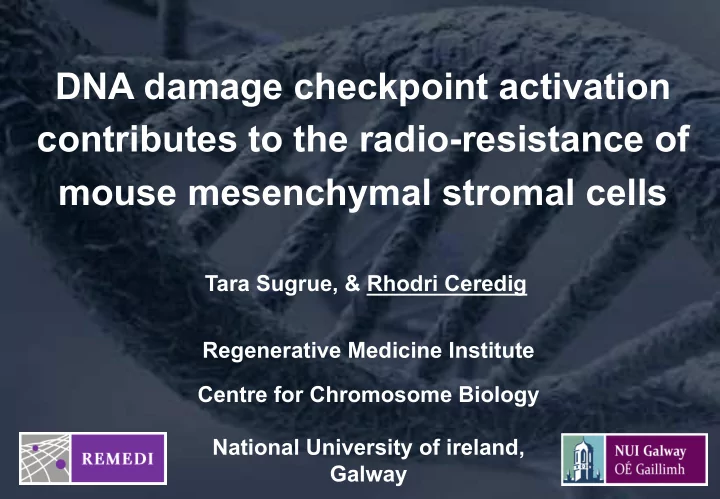

DNA damage checkpoint activation contributes to the radio-resistance of mouse mesenchymal stromal cells Tara Sugrue, & Rhodri Ceredig Regenerative Medicine Institute Centre for Chromosome Biology National University of ireland, Galway
The DNA Damage Response contributes to MSC radio-resistance
Radiation Response of the Bone Marrow IR Mesenchymal stromal cell Survive (MSC) Die Haematopoietic stem cell (HSC) Haematopoietic failure Rieger K, Marinets O, Fietz T et al. Mesenchymal stem cells remain of host origin even a long time after allogeneic peripheral blood stem cells or bone marrow transplantation. Exp Hematol 2005;33:605-611. Dickhut A, Schwerdtfeger R, Kuklick L et al. Mesenchymal stem cells obtained after bone marrow transplantation or peripheral blood stem cells transplantation originate from host tissue. Ann Hematol 2005;84:722-727.
Isolation of mouse MSCs CD44 ‘’ Bulk MSCs ’’ CD73 CD90 Heterogenous population. CD105 Sca-1 “CFU-F” Homogenous Mouse MSC line Clonal expansion population
Role of the DNA Damage Response in mediating the radio- resistance of MSCs Mouse mesenchymal stromal Mouse haematopoietic V cell line cell line MS5 ST4.5 CD4 + CD8 + Thymocyte Radio-resistant Radio-sensitive
The DNA Damage Response IR Chromatin DSB Activation of sensor and transducer proteins Signalling to effector proteins Effector Scaffolding Regulatory kinases proteins proteins Cell Cycle Arrest DNA Repair Transcription Apoptosis
Tracking cell cycle progression BrdU G1 S G2 M S G 1 Cell count BrdU G 2 +M S G 2 + M G 1 2n 4n PI DNA content (PI)
MSCs activate IR-induced DNA Damage checkpoints Time post irradiation (10 Gy) 0 hrs 2 hrs 4 hrs 12 hrs S MS5 G 1 G 2 /M ST4.5 BrdU PI 90 % S phase population 80 MS5 Control 70 MS5 10 Gy 60 50 40 30 20 ST4.5 Control 10 ST4.5 10 Gy 0 0 1 2 4 6 8 12 24 36 48 72 Time (Hrs)
MSCs recover from DNA damage checkpoint activaton Time post irradiation (10 Gy) 0 hrs 12 hrs 24 hrs 72 hrs S MS5 G 1 G 2 /M ST4.5 BrdU PI % BrdU labelled G1 population 80 MS5 Control 70 MS5 10 Gy 60 ST4.5 Control 50 40 ST4.5 10 Gy 30 20 10 0 0 1 2 4 6 8 12 24 36 48 72 Time (Hrs)
MSCs suppress IR-induced Apoptosis Time post irradiation (10 Gy) Untreated 2 hrs 4 hrs 12 hrs 36 hrs MS5 ST4.5 PI Annexin V 100 ST4.5 % Annexin V positive cells 80 60 40 20 MS5 0 0 2 4 8 12 24 36 Time post 10 Gy irradiation (Hrs)
Conclusions Ø MSCs survive long-term post high dose γ -irradiation. Ø MSCs activate a robust DNA Damage Response via rapid γ -H2AX formation. Ø MSCs recover from IR-induced DNA damage by: (i) Activating DNA damage checkpoint mechanisms. (ii) Activating DNA DSB repair. (iii) Preventing induction of apoptosis.
Acknowledgements NUI Galway Regenerative Centre for Medicine Institute Chromosome Biology Prof. Rhodri Ceredig Prof. Noel Lowndes Dr. James Brown Genome Stability Prof. Matthew Griffin Laboratory Immunology Group Dr. Michael Rainey Immunology and Transplant Biology Dr. Alessandro Natoni Group Simona Moravcová Michelle Duffy Senthilkumar Alagesan
Recommend
More recommend